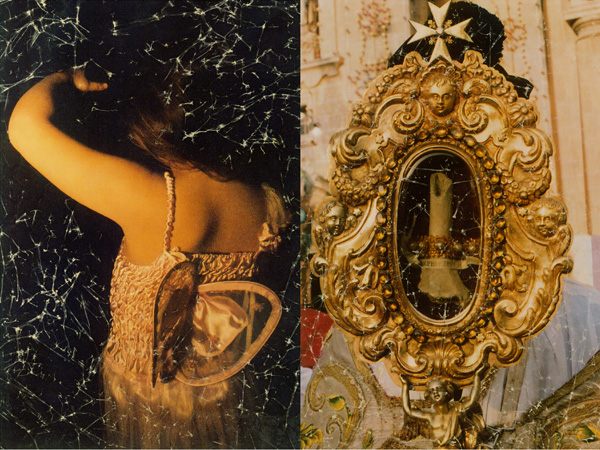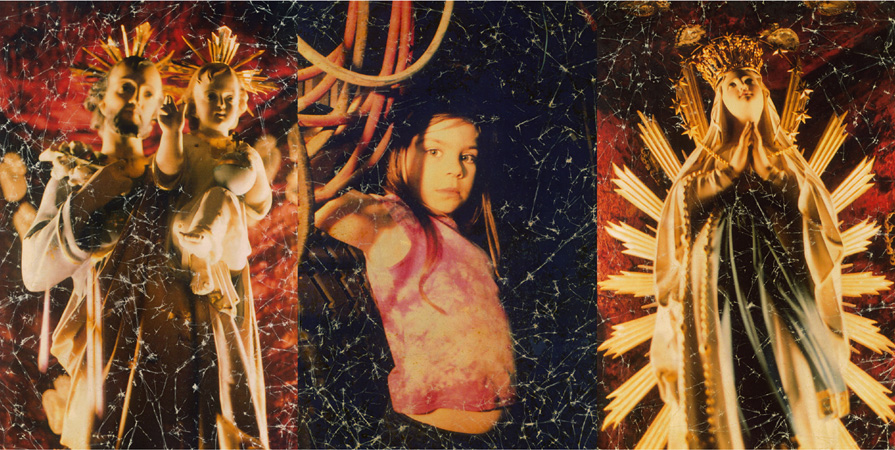Chaos and Revelry: Neo-Baroque & Camp Aesthetics
The neo-baroque shares a baroque delight in spectacle and sensory experiences (Angela Ndalianis 2004:5)
…the essence of Camp is its love of the unnatural: of artifice and exaggeration. And Camp is esoteric–something of a private code, a badge of identity even, among small urban cliques (Susan Sontag 1966: 275)
Chaos and Revelry presents the work of eight leading contemporary Australian artists who express a Neo-Baroque or Camp sensibility in their work: Maree Azzopardi, Kate Cotching, William Eicholtz, Felicity Rose Hardy, eX de Medici, Alex Martinis Roe, Deborah Paauwe and Darren Wardle. This small survey exhibition explores and revels in Neo-Baroque and Camp aesthetics, which operate under a logic of extravagance, spectacle, pleasure, excess, chaos and artifice. Visual and sensorial seductiveness are central to the Neo-Baroque and Camp and are manifested through the forms, surfaces, styles and themes of the work.
There are several hypothesise about the etymology of the word Baroque. One theory is that it came from the Italian word Barocco (or Baroco) that translates as bizarre or extravagant. Another theory is that it derives from the Spanish word Barueco, or Portuguese Barroco, which refers to an irregular or oddly shaped pearl. Whatever its origin, the Baroque implies lavishness, decadence, eccentricity, chaos and revelry. It is closely linked to the pleasures and sensations of the body.
Although the Baroque is often associated with a specific era, that of the seventeenth century, and sometimes a specific location (Italy during this period), Baroque style, form and concerns actually manifest themselves in art and other cultural media across time. As a style of art, the Baroque accumulated derogatory connotations during the eighteenth and nineteenth centuries, becoming known as an art of excess, disorder, irrationality and vulgarity. Art historian Erwin Panofsky (1995) claims that the Baroque, “came to signify everything wildly abstruse, obscure, fanciful, and useless” (19). In light of this, the historical Baroque was seen as being in opposition to the disciplines and philosophies of Neoclassicism and the Enlightenment.
This historical understanding of the Baroque has been challenged by Omar Calabrese (1992), who asserts that the Classical and the Baroque always co-exited, and continue to co-exist, even if one form dominates the other during a particular era. Calabrese argues that, “the baroque might be found in any epoch of our civilization” (1992:15). Rather than seeing the Baroque and Classical as historical art movements that are in opposition to one another, they may be seen as “categories of form (of expression or of content)” (Calabrese 1992:15-16).
Similarly, Camp operates as a form of expression and subject matter. Camp emerged as a postmodern, or late Modernist, aesthetic and cultural phenomenon. It shares affinities with the Neo-Baroque including a tendency towards artifice, instability, chaos, theatricality and excess. Broadly speaking, both the Neo-Baroque and Camp can be interpreted as a rebellion against the ideologies of rationalism and functionalism. These aesthetics had a significant impact on the art, architecture, cinema, and fashion styles of the nineteenth and twentieth centuries, and they continue to reveal themselves in contemporary artistic practice.
In this era, Neo-Baroque and Camp sensibilities are discernible through a diversity of techniques, forms and concerns. The tendency towards illusionism, immersive aesthetics, installation-based practice, large-scale photographs and performance in the visual arts can be seen as a fascination with exploring and creating Neo-Baroque and Camp sensibilities. Ornamental sculptures and hyper-coloured paintings also reflect a Neo-Baroque and Camp interest in excessive embellishment.
Neo-Baroque and Camp artworks often draw attention back to the body as the site of sensation through the materiality of the media and the content of the work. The highly ornamental sculptures of William Eicholtz embody a Neo-Baroque and Camp aesthetic through their excessive decoration and theatricality. Eicholtz draws upon the iconography and mythology of the Australian pastoral landscape and European aristocracy, translating symbols such as the shepherd and sheep into flamboyant, high camp figures. The materiality of these works is overtly seductive, tempting the viewer to touch and explore their surfaces and folds.
The focus on illusionism in contemporary art may be seen as another sign of the Neo-Baroque. Desire Overcoming Duality alludes to a key concern in eX de Medici’s work – issues of power and power relations between individuals. The fine detail of this work reveals the obsessive and labour intensive process involved in the making of the work and references the artist’s creative practice as a tattooist. The work includes several of de Medici’s recurring motifs, specifically skulls and jewels. Although these culturally loaded symbols are instantly recognisable, de Medici has created an illusory effect by re-presenting them as lavishly decorated, amorphic and botanical objects. The illusionism inherent in the work seems to articulate a longing for transformation while paradoxically implying an anxiety about change.
Deborah Paauwe’s large-scale photographs focus attention on the intimate interface between clothing and the body, and in turn the relationship between clothing and identity. The colour and embellishment of the pageant dresses worn by the girls in the Magic Window series and the carefully arranged chiffon and tulle in The Crying Room evoke romantic ideals of girlhood and womanhood. As appealing as these images seem, the fantasy is disrupted by the vulnerability of the figures and the goose-bumps, blemishes and scratches on the skin of the subjects. These physical imperfections reveal the corporeal reality of the body. An ambiguity exists in the way Paauwe’s photographs entice the viewer into looking at the female figures on display, while also highlighting their voyeuristic gaze.
Darren Wardle’s vividly coloured, abstract painting almost assaults the viewer with its intensity. The ironically titled Xanax, has a psychedelic and hallucinatory affect that evokes a flight from reality, rather than a return to tranquillity. This colour-saturated painting possesses a luminosity that lends it a fluid and screen-like quality, reflecting Wardle’s ongoing concern with the interface between digital technologies and painting.
The historical and contemporary become fused in Maree Azzopardi’s new series of photographs that explore her own childhood memories. Drawing upon religious iconography from the church in her family’s village in Malta and photographs of her own niece, Angel Blood, Wings and The Family represent memories of growing up as a girl in a Catholic, Maltese family. These visually luscious works are deeply personal and imply the significant influence that Azzopardi’s cultural and religious upbringing have had on her sense of identity and artistic practice.
Kate Cotching’s intricate paper installations involve the careful cutting of layers of hand-coloured paper. An apparently chaotic industrial landscape is presented in An establishment for the diffusion of knowledge (2005). Fragments of cranes and buildings overlap and interweave in an irrational manner, creating an impression of disorder within this highly ordered work. The turmoil and fragility of this beautiful work implies a concern with the instability of reality and the constructed environment.
Alex Martinis Roe produces performance-based installations that draw attention to bodily gestures. Her works reflect an interest in contemporary feminist politics, specifically the critique of representations of the body and the performativity of gender. Physical gestures are often repeated to the point where they become camp, choreographed dance movements. In Up and Down, Martinis Roe mimics Madonna’s hand movements from the Vogue film-clip, repeating these gestures in a camp and highly theatrical performance as she climbs up and down a ladder, constantly advancing and retreating from the viewer.
Felicity Rose Hardy has drawn upon her extensive experience as a wearable art and textile artist and costume designer to create a series of Baroque inspired objects. Each work revolves around a wearable motif such as a mask, shoe or glove. These objects incorporate materials collected by the artist over time because of their unique and curious qualities. Hardy extends the Baroque tradition of using excessive flourish and decoration in the creation of objects, while also engaging with the practice of collecting and displaying curiosities. In a sense, these works are about the desire and impulse to collect and preserve beautiful things that serve no practical function. Ironically, Hardy transforms useless materials into art, which some people might say serves no practical function.
Edwina Bartlem
Curator
Bibliography
Calabrese, Omar 1992, Neo-Baroque: A Sign of the Times, Trans. Charles Lambert, Princeton University Press, Princeton, New Jersey. Ndalianis, Angela 2004, Neo-Baroque Aesthetics and Contemporary Entertainment, The MIT Press, Cambridge, Massachusetts and London, England. Panofsky, Erwin 1995, Three Essays on Style, The MIT Press, Cambridge, Massachusetts and London, England. Sontag, Susan 1966, “Notes on “Camp”’, in Against Interpretation And Other Essays, Delta Book, New York.
Reviews of Chaos & Revelry:






